
Am Fam Physician. 2016;93(1):49-54A
Patient information: A handout on this topic is available at https://familydoctor.org/familydoctor/en/diseases-conditions/somatoform-disorders/symptoms.html.
Author disclosure: No relevant financial affiliations.
With the release of the Diagnostic and Statistical Manual of Mental Disorders, 5th ed., the diagnostic category previously known as somatoform disorders is now called somatic symptom and related disorders. The revisions were intended to increase their relevance in the primary care setting. The main feature of this disorder is a patient's concern with physical symptoms that he or she attributes to a nonpsychiatric disease. Primary care physicians often treat patients who manifest symptoms for which there are no biologic cause, and patients with somatic symptom disorder may be subjected to unnecessary testing and procedures. As a result, appropriate diagnosis is essential. Screening instruments are useful in determining the presence of somatic symptom disorder. It is important for the primary care physician to schedule regular appointments, establish a strong therapeutic alliance, acknowledge and legitimize the patient's symptoms, and limit diagnostic testing or referrals to subspecialists. Proven treatments include cognitive behavior therapy, mindfulness-based therapy, and pharmacotherapy. The use of selective serotonin reuptake inhibitors or tricyclic antidepressants has been effective in alleviating symptoms. Referral to a mental health professional may be necessary when treatment by the primary care physician is ineffective.
Somatization is said to be present when psychological or emotional distress is manifested in the form of physical symptoms that are otherwise medically unexplained.1 Patients with multiple persistent physical symptoms that seem to have no apparent biologic basis are common in patients presenting to primary care.2
| Clinical recommendation | Evidence rating | References |
|---|---|---|
| In addition to a comprehensive clinical interview and assessment for diagnostic criteria, the use of screening instruments, such as the Patient Health Questionnaire-15 or the Somatic Symptom Scale-8, should be considered in patients with suspected somatic symptom disorder. | C | 14, 15 |
| Cognitive behavior therapy and mindfulness-based therapy are effective for the treatment of somatic symptom disorder. | B | 18–24 |
| Amitriptyline, selective serotonin reuptake inhibitors, and St. John's wort are effective pharmacologic treatments for somatic symptom disorder. | B | 25–27 |
| Other antidepressants (monoamine oxidase inhibitors, bupropion [Wellbutrin], anticonvulsants, and antipsychotics) are ineffective for the treatment of somatic symptom disorder and should be avoided. | B | 25 |
In the Diagnostic and Statistical Manual of Mental Disorders, 5th ed., (DSM-5), the nomenclature for the diagnostic category previously known as somatoform disorders was changed to somatic symptom and related disorders.3 The purpose of this change was to better define these disorders to make them more relevant to the primary care setting.
Somatic symptom disorder may be no less debilitating than physical disorders.4 Patients experiencing somatization whose physicians incorrectly think they may have a biologic disorder can experience harm from unnecessary testing and treatment.5 Some physicians find patients with somatic symptom disorder frustrating, and may describe them in derogatory terms. They may consider physical disorders genuine, while essentially accusing somaticizing patients of manufacturing their symptoms.6 This article provides practical suggestions for improving the care of these patients.
Epidemiology
The prevalence of somatic symptom disorder in the general population is an estimated 5% to 7%,3 making this one of the most common categories of patient concerns in the primary care setting.7 An estimated 20% to 25% of patients who present with acute somatic symptoms go on to develop a chronic somatic illness.8 These disorders can begin in childhood, adolescence, or adulthood.4,9 Females tend to present with somatic symptom disorder more often than males, with an estimated female-to-male ratio of 10:1.9
Etiology
Somatic symptoms may result from a heightened awareness of certain bodily sensations, combined with a tendency to interpret these sensations as indicative of a medical illness.9 The etiology of somatic symptom disorder is unclear. However, studies have determined that risk factors for chronic and severe somatic symptoms include childhood neglect, sexual abuse, chaotic lifestyle, and a history of alcohol and substance abuse. In addition, somatic symptom disorder has been associated with personality disorders.8
Psychosocial stressors and culture affect how patients present to the physician. For example, studies in primary care settings found significantly higher rates of unemployment and impaired occupational functioning in somaticizing patients compared with nonsomaticizing patients (29% vs. 15%, and 55% vs. 14%, respectively).4 Patients may also present with physical symptoms when psychiatric symptoms are stigmatized, as in some cultures.10
Diagnosis
Somatic symptom disorder presents a problem for both the physician and patient because it puts patients at risk of unnecessary testing and treatment.8,9,11 The main feature of these disorders is a concern with physical symptoms that are attributed to a nonpsychiatric disease.12 This concern can manifest as one or more somatic symptoms that result in excessive thoughts, feelings, or behaviors related to those symptoms and that are distressing or result in significant disruption of daily life. One of the following criteria must also be present: significant thoughts about the seriousness of the symptoms; a high level of anxiety about the symptoms; or excessive energy spent with regard to symptomatic concern. Although somatic symptoms need not be continuously present, they must be persistent (present for more than six months). Two specifiers of this condition in the DSM-5 are “with predominant pain” and “persistent.” These disorders can be mild, moderate, or severe (Table 1).3 Characteristics of the subclasses of somatic symptom disorder are described in Table 2.3
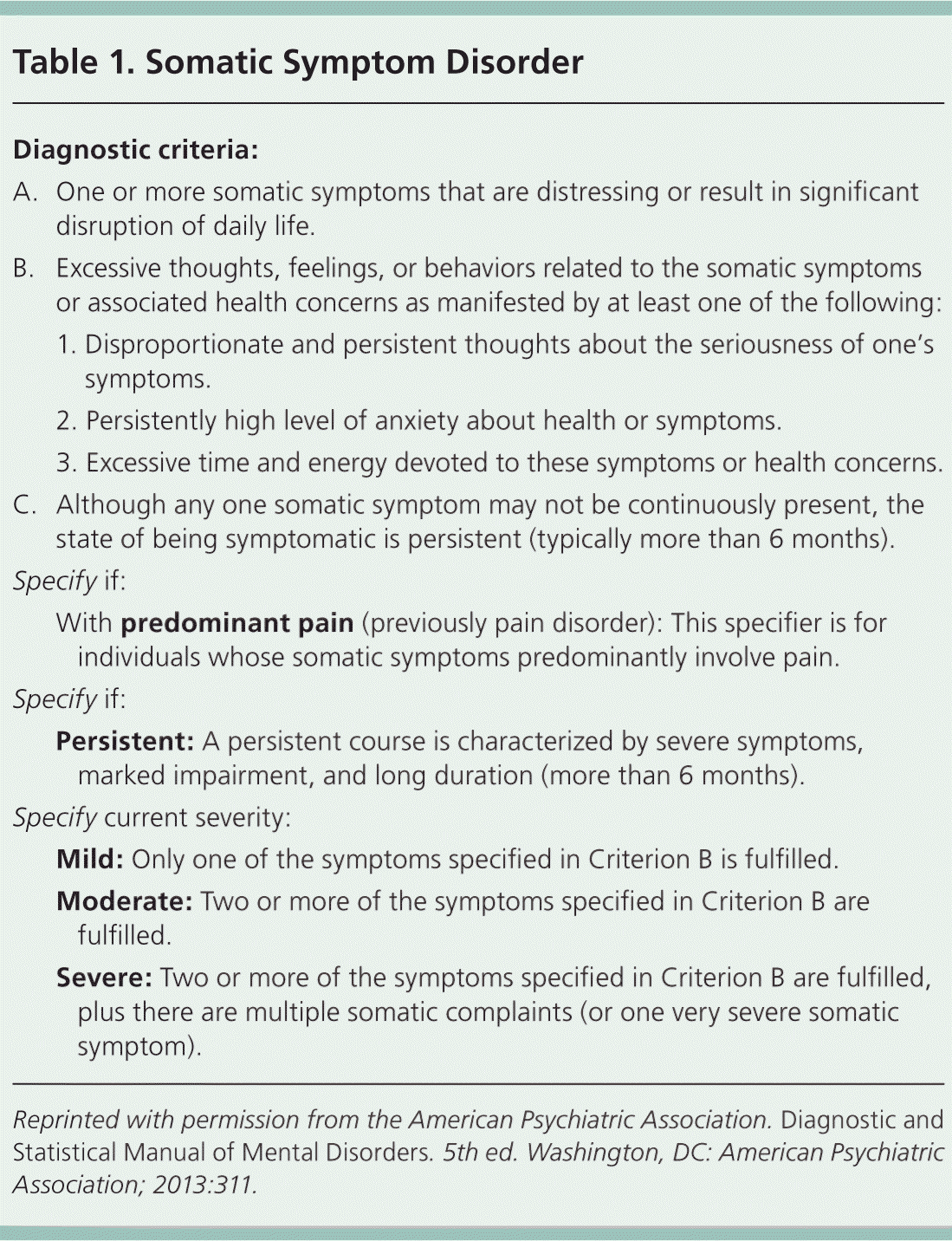
| Diagnostic criteria: | |
| A. One or more somatic symptoms that are distressing or result in significant disruption of daily life. | |
| B. Excessive thoughts, feelings, or behaviors related to the somatic symptoms or associated health concerns as manifested by at least one of the following: | |
| 1. Disproportionate and persistent thoughts about the seriousness of one's symptoms. | |
| 2. Persistently high level of anxiety about health or symptoms. | |
| 3. Excessive time and energy devoted to these symptoms or health concerns. | |
| C. Although any one somatic symptom may not be continuously present, the state of being symptomatic is persistent (typically more than 6 months). | |
| Specify if: | |
| With predominant pain (previously pain disorder): This specifier is for individuals whose somatic symptoms predominantly involve pain. | |
| Specify if: | |
| Persistent: A persistent course is characterized by severe symptoms, marked impairment, and long duration (more than 6 months). | |
| Specify current severity: | |
| Mild: Only one of the symptoms specified in Criterion B is fulfilled. | |
| Moderate: Two or more of the symptoms specified in Criterion B are fulfilled. | |
| Severe: Two or more of the symptoms specified in Criterion B are fulfilled, plus there are multiple somatic complaints (or one very severe somatic symptom). | |
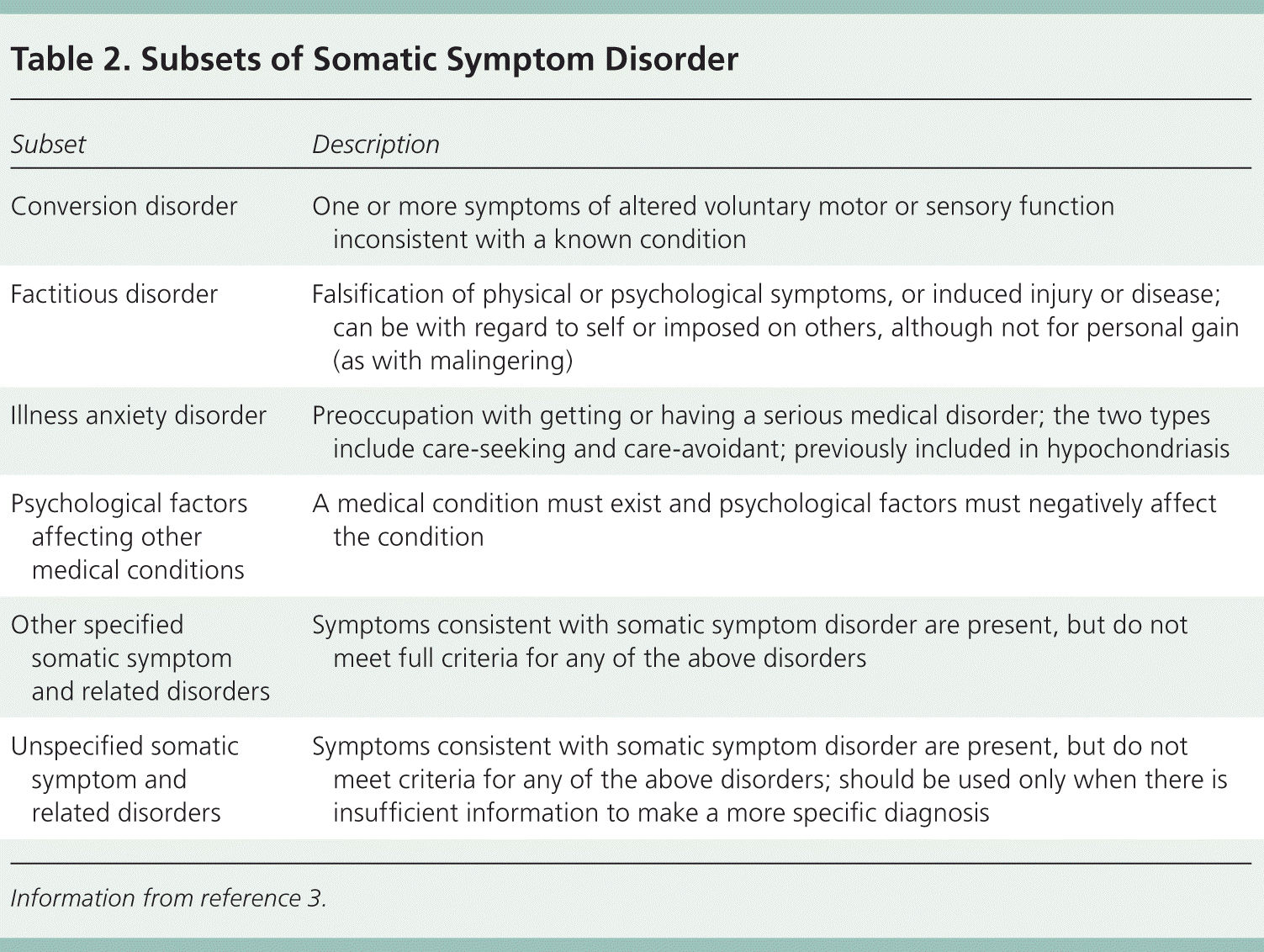
| Subset | Description |
|---|---|
| Conversion disorder | One or more symptoms of altered voluntary motor or sensory function inconsistent with a known condition |
| Factitious disorder | Falsification of physical or psychological symptoms, or induced injury or disease; can be with regard to self or imposed on others, although not for personal gain (as with malingering) |
| Illness anxiety disorder | Preoccupation with getting or having a serious medical disorder; the two types include care-seeking and care-avoidant; previously included in hypochondriasis |
| Psychological factors affecting other medical conditions | A medical condition must exist and psychological factors must negatively affect the condition |
| Other specified somatic symptom and related disorders | Symptoms consistent with somatic symptom disorder are present, but do not meet full criteria for any of the above disorders |
| Unspecified somatic symptom and related disorders | Symptoms consistent with somatic symptom disorder are present, but do not meet criteria for any of the above disorders; should be used only when there is insufficient information to make a more specific diagnosis |
Differential Diagnosis
The following diagnoses should be considered in patients with suspected somatic symptom disorder because the symptoms may be indicative of other mental health disorders: depression, panic disorder, generalized anxiety disorder, substance use disorder, syndromes of unclear etiology (e.g., nonmalignant pain syndrome, chronic fatigue syndrome), and nonpsychiatric medical conditions.12
Screening
Although the Patient Health Questionnaire-15 (eTable A) is perhaps the most commonly used screening instrument to detect somatization symptoms in the general population,13 the more recently developed Somatic Symptom Scale-8 (Table 314) shows promise in measuring somatic symptom burden. A study to determine the reliability and validity of this newer tool concluded that it is a reliable and valid self-report measure of somatic symptom burden, and that cutoff scores identify persons with low, medium, high, and very high somatic symptom burden.15 This instrument was validated on a representative random sample, including 2,510 persons 14 years and older, with overall good reliability. Because of overlap with symptoms of depression and anxiety, it is recommended that clinicians assess for these comorbidities as well.14 It should be emphasized, however, that although screening instruments are useful as a first step in the diagnostic process, the DSM-5 criteria still must be met to diagnose somatic symptom disorders.
| During the past four weeks, how much have you been bothered by the following symptoms? | |||
|---|---|---|---|
| Symptom | Not at all | A little | A lot |
| Back pain | 0 | 1 | 2 |
| Chest pain | 0 | 1 | 2 |
| Constipation, loose bowels, or diarrhea | 0 | 1 | 2 |
| Dizziness | 0 | 1 | 2 |
| Fainting | 0 | 1 | 2 |
| Feeling tired or having low energy | 0 | 1 | 2 |
| Feeling your heart pound or race | 0 | 1 | 2 |
| Headaches | 0 | 1 | 2 |
| Menstrual cramps or other problems with your periods (women only) | 0 | 1 | 2 |
| Nausea, gas, or indigestion | 0 | 1 | 2 |
| Pain in your arms, legs, or joints | 0 | 1 | 2 |
| Pain or problems during sexual intercourse | 0 | 1 | 2 |
| Shortness of breath | 0 | 1 | 2 |
| Stomach pain | 0 | 1 | 2 |
| Trouble sleeping | 0 | 1 | 2 |
| Score: | ______ | ||
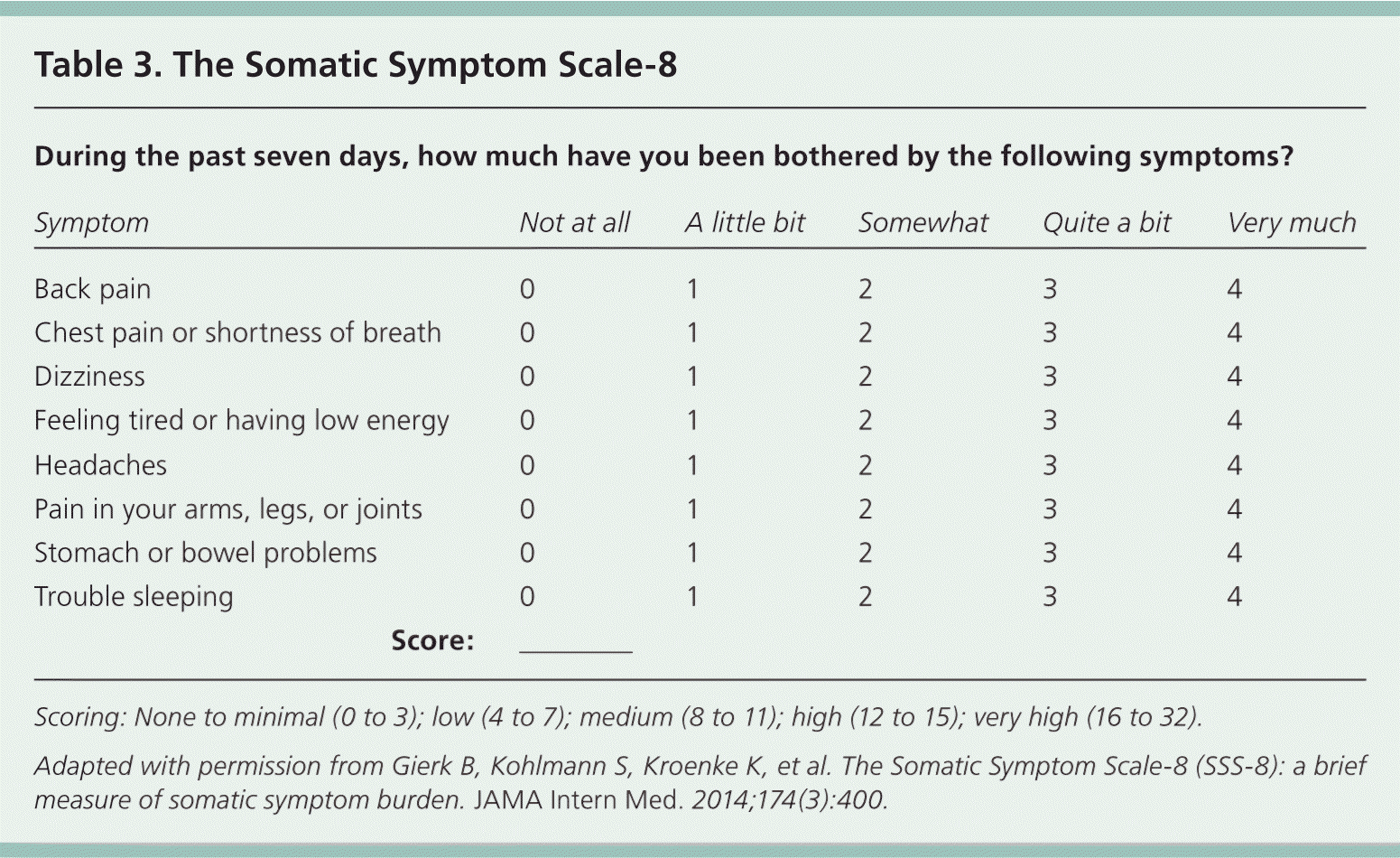
| During the past seven days, how much have you been bothered by the following symptoms? | |||||
|---|---|---|---|---|---|
| Symptom | Not at all | A little bit | Somewhat | Quite a bit | Very much |
| Back pain | 0 | 1 | 2 | 3 | 4 |
| Chest pain or shortness of breath | 0 | 1 | 2 | 3 | 4 |
| Dizziness | 0 | 1 | 2 | 3 | 4 |
| Feeling tired or having low energy | 0 | 1 | 2 | 3 | 4 |
| Headaches | 0 | 1 | 2 | 3 | 4 |
| Pain in your arms, legs, or joints | 0 | 1 | 2 | 3 | 4 |
| Stomach or bowel problems | 0 | 1 | 2 | 3 | 4 |
| Trouble sleeping | 0 | 1 | 2 | 3 | 4 |
| Score: | ______ | ||||
Management
The management of somatic symptom disorders requires a multifaceted approach tailored to the individual patient. To choose the correct treatment plan, primary care clinicians should keep in mind psychological, social, and cultural factors that influence somatic symptoms.
General treatment tenets for the primary care clinician include scheduling regular, short-interval visits to avoid the need for symptoms to get an appointment; establishing a collaborative, therapeutic alliance with the patient; acknowledging and legitimizing symptoms once the patient has been evaluated for other medical and psychiatric diseases; limiting diagnostic testing; reassuring the patient that serious medical diseases have been ruled out; educating patients about coping with physical symptoms; setting a treatment goal of functional improvement rather than cure; and appropriately referring patients to subspecialists and mental health professionals.16 The CARE MD (consultation/cognitive behavior therapy, assessment, regular visits, empathy, medical/psychiatric interface, do no harm) treatment approach was developed to help primary care clinicians work more effectively with patients who have somatic symptom disorder (Table 4).17 Proven therapies provided by mental health care professionals include cognitive behavior therapy and mindfulness-based therapy (Table 5).18–27
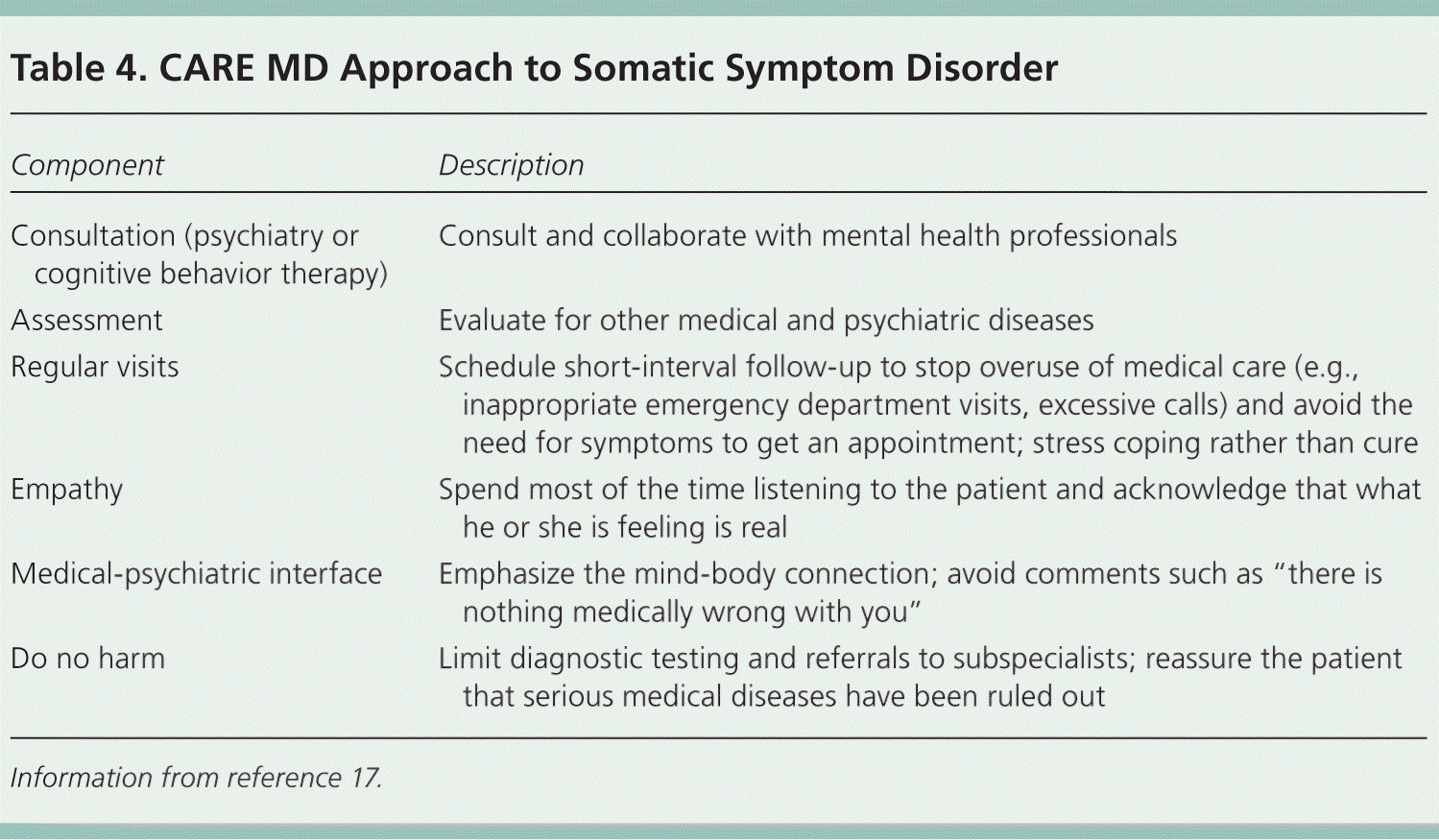
| Component | Description |
|---|---|
| Consultation (psychiatry or cognitive behavior therapy) | Consult and collaborate with mental health professionals |
| Assessment | Evaluate for other medical and psychiatric diseases |
| Regular visits | Schedule short-interval follow-up to stop overuse of medical care (e.g., inappropriate emergency department visits, excessive calls) and avoid the need for symptoms to get an appointment; stress coping rather than cure |
| Empathy | Spend most of the time listening to the patient and acknowledge that what he or she is feeling is real |
| Medical-psychiatric interface | Emphasize the mind-body connection; avoid comments such as “there is nothing medically wrong with you” |
| Do no harm | Limit diagnostic testing and referrals to subspecialists; reassure the patient that serious medical diseases have been ruled out |
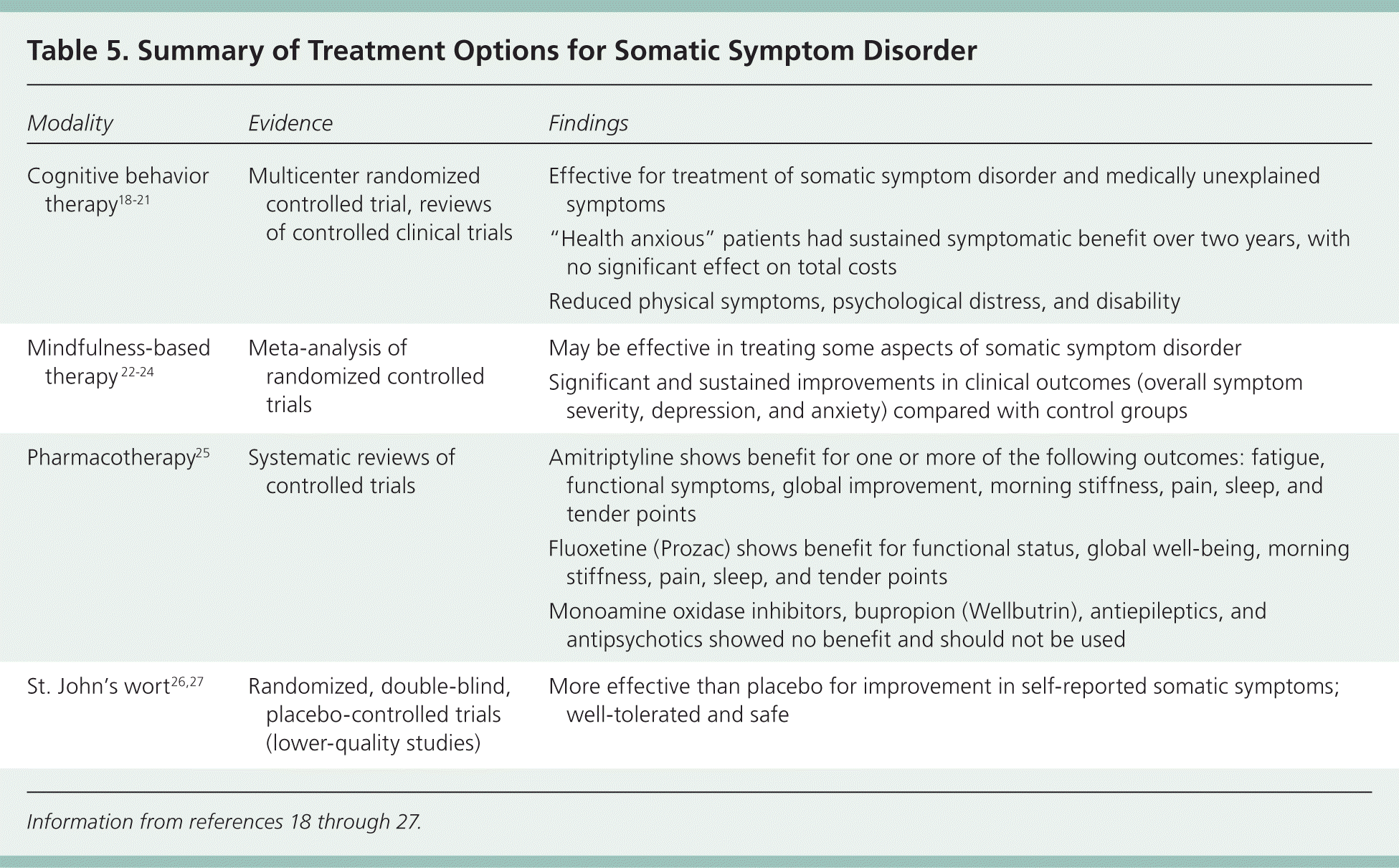
| Modality | Evidence | Findings |
|---|---|---|
| Cognitive behavior therapy18–21 | Multicenter randomized controlled trial, reviews of controlled clinical trials | Effective for treatment of somatic symptom disorder and medically unexplained symptoms |
| “Health anxious” patients had sustained symptomatic benefit over two years, with no significant effect on total costs | ||
| Reduced physical symptoms, psychological distress, and disability | ||
| Mindfulness-based therapy 22–24 | Meta-analysis of randomized controlled trials | May be effective in treating some aspects of somatic symptom disorder |
| Significant and sustained improvements in clinical outcomes (overall symptom severity, depression, and anxiety) compared with control groups | ||
| Pharmacotherapy25 | Systematic reviews of controlled trials | Amitriptyline shows benefit for one or more of the following outcomes: fatigue, functional symptoms, global improvement, morning stiffness, pain, sleep, and tender points |
| Fluoxetine (Prozac) shows benefit for functional status, global well-being, morning stiffness, pain, sleep, and tender points | ||
| Monoamine oxidase inhibitors, bupropion (Wellbutrin), antiepileptics, and antipsychotics showed no benefit and should not be used | ||
| St. John's wort26,27 | Randomized, double-blind, placebo-controlled trials (lower-quality studies) | More effective than placebo for improvement in self-reported somatic symptoms; well-tolerated and safe |
PHARMACOTHERAPY
Medications used to treat somatic symptom disorder include antidepressants, antiepileptics, antipsychotics, and natural products. The effectiveness of many of these treatments has limited support.
Systematic reviews of controlled trials support the use of antidepressants for the treatment of somatic symptom disorder. In a meta-analysis of 94 trials, antidepressants provided substantial benefit, with a number needed to treat of three.25 Tricyclic antidepressants had notable success and were associated with a greater likelihood of effectiveness than selective serotonin reuptake inhibitors. Amitriptyline was the most studied tricyclic, and provided benefits for at least one of the following outcomes: pain, morning stiffness, global improvement, sleep, fatigue, tender point score (based on the number and severity of tender points), and functional symptoms. Of the selective serotonin reuptake inhibitors studied, fluoxetine (Prozac) demonstrated benefit for pain, functional status, global well-being, sleep, morning stiffness, and tender points.26
There is little support for the use of mono-amine oxidase inhibitors, bupropion (Wellbutrin), antiepileptics, or antipsychotics in the treatment of somatic symptom disorder. These medications have significant adverse effects and are best avoided for this use.25
Prognosis
Somatic symptom disorders are generally chronic, with waxing and waning symptoms. However, some studies have shown that patients can recover; the natural history of the disorders suggests that approximately 50% to 75% of patients with medically unexplained symptoms show improvement, whereas 10% to 30% deteriorate.28 Better prognostic indicators include having fewer physical symptoms and better functioning at baseline.28,29 A strong, positive relationship between the physician and the patient is essential and should be coupled with frequent, supportive visits, while avoiding the temptation to medicate or test when these interventions are not clearly indicated.
Data Sources: Medline searches via Ovid and PubMed were completed using the key terms somatoform disorder, somatization, somatic, medically unexplained symptoms, and treatment. The search included reviews, meta-analyses and randomized controlled trials. Also searched were the Cochrane Database of Systematic Reviews, Essential Evidence Plus, UpToDate, and evidence-based guidelines from the National Guideline Clearinghouse. Search dates: August 2014 through November 2014.
